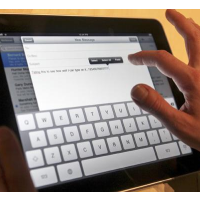L.A. Schools Too Busy Rolling Out iPads to Actually Use Them
 iPad (photo: Reuters)
iPad (photo: Reuters)
Los Angeles schools were so busy handing out iPads to its 640,000 students in a hasty, misconceived $1.3-billion program that it didn’t have time to actually prepare anyone to use them for education. And so, for the most part, teachers and students did not.
That’s the verdict from American Institutes for Research (AIR) in an interim report (pdf) released this week on what went wrong at Los Angeles Unified School District (LAUSD). “The early implementation goal was to just get the devices out, that was basically it, just get the devices out, use them as quick as possible,” according to one of the 14 “virtual learning complex facilitators” hired by LAUSD. “There were other goals . . ., they were talked about but they really didn’t get implemented.”
Those goals included giving students a leg up on adoption of new Common Core education standards that are being sporadically adopted nationwide. And low-income students would be brought to a new level of computer literacy previously thought unattainable.
The district abruptly halted distribution of the computing devices in August after a disastrous rollout clouded by questions of impropriety between LAUSD officials and suppliers of goods and services related to the program. Around 109,000 iPads have already been purchased but just 62,000 have the required Pearson curriculum for teaching loaded. Not that it would have mattered.
“At nearly all schools, staff stated that the Pearson curriculum that was promised during initial . . . trainings was not available during the school year,” the report said. “Overall, staff voiced concerns about the functionality of the Pearson application.”
The district was going to spend $500 million in bond money for the computers and another $500 million on Wi-Fi and incidentals. The decision to use bond money earmarked for school construction and repair work to kickstart the program was not universally acclaimed.
Problems surfaced immediately in the very limited first-stage of the iPad rollout. Virtual keyboards proved impractical, so $38 million in real keyboards was put on the tab. Kids hacked their way past security barriers to use banned social media—and access websites they legitimately needed for homework. The district belatedly struggled to create a policy for handling lost or broken iPads.
Schools Superintendent John Deasy and then-deputy Jaime Aquino came under fire for questionable private discussions with vendors before the public contract process began.
AIR researchers visited 245 classrooms in 19 schools in May to gather information for the report. They found the Pearson curriculum being taught in just one classroom and complaints about it abounded. The program was slow to load, logging in was problematic and various parts of the curriculum were missing, like the lack of high school math, but that appeared to be by design. The software was meant as a sample of offerings that could be added to later.
An examination of the iPads found the most popular downloads by students were from YouTube, Pandora, Subway Surfers, Snapchat, Piano Tiles and Asphalt 8. The string of nonacademic downloads was broken at No. 7 by ST Math. But only three more academic sites made the Top 20: Dictionary at No. 9, Edmodo at No. 10 and Lexia Core5 at No. 18. Apps included along the way were Google Drive, Flappy Bird, SoundCloud, INJUSTICE, Smash Hit and Dropbox.
Edmodo topped teacher downloads, followed by Dropbox, Netflix and Pandora. CommonCore edged out YouTube for the No. 5 spot.
The report said the lack of academic downloads was because each machine came equipped with a range of educational programs.
The LAUSD’s iPad project is not dead. The five-year program has been slowed while assessments inside and outside the school district proceed and the politics play out. Phase I included 47 schools. The Phase II expansion to 38 more schools, set to begin in January, has been pushed back to Fall 2014 and Phase III has yet to be approved by the school board.
–Ken Broder
To Learn More:
LAUSD iPad Report: Electronic Learning Hampered by Lack of Technical Support (by Thomas Himes, Los Angeles Daily News)
L.A. Unified Survey Finds Little Use of iPads' Curriculum (by Howard Blume, Los Angeles Times)
L.A. Schools Chief Abruptly Ends $1-Billion iPads-for-All Program (by Ken Broder, AllGov California)
Evaluation of the Common Core Technology Project (American Institutes for Research) (pdf)
- Top Stories
- Controversies
- Where is the Money Going?
- California and the Nation
- Appointments and Resignations
- Unusual News
- Latest News
- California Forbids U.S. Immigration Agents from Pretending to be Police
- California Lawmakers Urged to Strip “Self-Dealing” Tax Board of Its Duties
- Big Oil’s Grip on California
- Santa Cruz Police See Homeland Security Betrayal in Use of Gang Roundup as Cover for Immigration Raid
- Oil Companies Face Deadline to Stop Polluting California Groundwater





